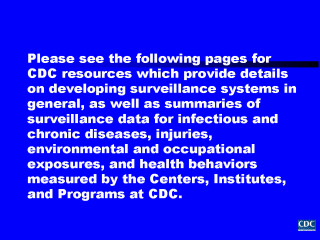| front |1 |2 |3 |4 |5 |6 |7 |8 |9 |10 |11 |12 |13 |14 |15 |16 |17 |18 |19 |20 |21 |22 |23 |24 |25 |26 |27 |28 |review |
 |
This concludes my presentation. I have shown you a few examples of the types of surveillance data analyses that you should undertake on a regular basis, and suggested some of the individuals and groups to whom this information should be reported and provided as feedback. Our goal is to conduct action-oriented surveillance, that is, to collect, analyze, and report back surveillance information that will have the highest likelihood of reaching those in a position to take public health action. More specifically, we want surveillance information to be used to develop, implement, and evaluate intervention programs and policies that will prevent, limit, and control the spread of disease, disability, and death. Thank you for your attention. If you have any questions, suggestions, or comments on how this presentation can be improved, please feel free to contact me through e-mail at the Centers for Disease Control and Prevention at: PChing@CDC.GOV. Following are a list of CDC resources which provide details on developing surveillance systems in general, as well as summaries of surveillance data for infectious and chronic diseases, injuries, environmental and occupational exposures, and health behaviors measured by the Centers, Institutes, and Programs at CDC. |
| front |1 |2 |3 |4 |5 |6 |7 |8 |9 |10 |11 |12 |13 |14 |15 |16 |17 |18 |19 |20 |21 |22 |23 |24 |25 |26 |27 |28 |review |